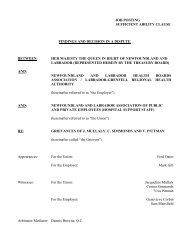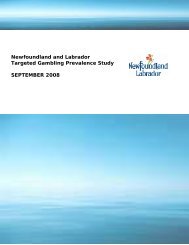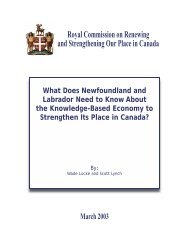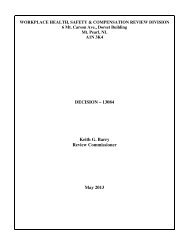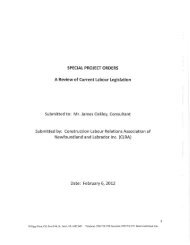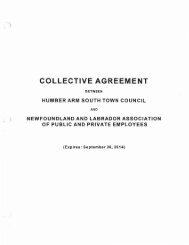Energy Plan - Government of Newfoundland and Labrador
Energy Plan - Government of Newfoundland and Labrador
Energy Plan - Government of Newfoundland and Labrador
You also want an ePaper? Increase the reach of your titles
YUMPU automatically turns print PDFs into web optimized ePapers that Google loves.
POLICY<br />
ACTIONS<br />
Gas–to–Wire<br />
The <strong>Government</strong> <strong>of</strong><br />
<strong>Newfoundl<strong>and</strong></strong> <strong>and</strong> <strong>Labrador</strong> will:<br />
• Explore options for gas-towire<br />
generation <strong>and</strong> delivery.<br />
POLICY<br />
ACTIONS<br />
Other Generation<br />
Technologies<br />
The <strong>Government</strong> <strong>of</strong><br />
<strong>Newfoundl<strong>and</strong></strong> <strong>and</strong> <strong>Labrador</strong> will:<br />
• Pursue other generation<br />
opportunities when they<br />
are technologically <strong>and</strong><br />
economically feasible.<br />
• Develop <strong>and</strong> implement a<br />
net metering policy for small<br />
generation developers.<br />
• Encourage exploration <strong>and</strong><br />
development <strong>of</strong> our uranium<br />
resources.<br />
Gas–to–Wire<br />
(Natural Gas–Fired Generation)<br />
When natural gas is produced from our <strong>of</strong>fshore it could be transported to<br />
customers, either as gas in a pipeline, as gas in a Compressed Natural Gas<br />
(CNG) tanker, or as a liquid in a Liquefied Natural Gas (LNG) tanker. L<strong>and</strong>ed in<br />
the province, it could be used to make electricity, which can then be transported<br />
to domestic <strong>and</strong> external markets by transmission lines. This process is known<br />
as gas-to-wire. Natural gas-fired generation can be significantly more efficient<br />
than systems fuelled by coal or, like Holyrood, heavy fuel oil <strong>and</strong> produce far less<br />
GHGs <strong>and</strong> other emissions. If natural gas can replace these other fuels, it will<br />
yield significant environmental benefits. Section 3 <strong>of</strong> this <strong>Energy</strong> <strong>Plan</strong> stated<br />
that the Provincial <strong>Government</strong> will request companies complete an analysis <strong>of</strong><br />
l<strong>and</strong>ing gas options prior to submitting a Development <strong>Plan</strong>.<br />
The economic feasibility <strong>of</strong> gas-to-wire will depend on a variety <strong>of</strong> factors, such as<br />
the total cost <strong>of</strong> producing, delivering <strong>and</strong> converting gas to electricity, compared<br />
to the current market value <strong>of</strong> electricity in the targeted marketplace.<br />
Other Generation Technologies<br />
A number <strong>of</strong> other technologies, including gas cogeneration (using natural<br />
gas from <strong>of</strong>fshore or, on a smaller scale, methane recovered from l<strong>and</strong>fills),<br />
cogeneration, biomass (wood), peat, tidal, small-scale wind, solar power <strong>and</strong><br />
micro-hydro, might be able to contribute to our electrical supply. Some <strong>of</strong><br />
these, notably cogeneration, are mature alternatives. Others are still in the<br />
developmental stages. Long-term business cases are required to support their<br />
use <strong>and</strong> they are highly sensitive to the sale price <strong>of</strong> the electricity. Together,<br />
they <strong>of</strong>fer the potential to supplement our renewable electricity portfolio.<br />
Some homeowners <strong>and</strong> small business operators have requested permission<br />
to install small generation units to produce power for themselves with the<br />
ability to feed some back into the system when they can produce more than<br />
they need. The Provincial <strong>Government</strong> will ensure that regulatory support is in<br />
place for customers who wish to develop these alternatives themselves on a<br />
small scale, through a net metering policy. NLH <strong>and</strong> <strong>Newfoundl<strong>and</strong></strong> Power have<br />
told <strong>Government</strong> they will make a joint proposal to the PUB to implement net<br />
metering for small-scale renewable energy sources, with due regard for safety,<br />
the environment <strong>and</strong> the community.<br />
Since electricity prices, <strong>and</strong> therefore the economic feasibility <strong>of</strong> these other<br />
generation technologies, will be strongly influenced by the availability <strong>of</strong> power<br />
from the Lower Churchill, Provincial <strong>Government</strong> support for these alternatives<br />
will be limited until certainty for the Lower Churchill Project is achieved <strong>and</strong> the<br />
long-term supply situation is known.<br />
40<br />
No role is foreseen for nuclear generation in the province. Even if provincial<br />
legislation prohibiting nuclear generation were not in place, more cost-effective<br />
<strong>and</strong> flexible hydro alternatives are already available to us <strong>and</strong> are well understood.<br />
This does not diminish the value <strong>of</strong> the province’s uranium deposits for export.<br />
Nuclear generation is enjoying a renaissance <strong>and</strong> can be more attractive than fossil<br />
fuel generation in many markets. New nuclear plants are under consideration in<br />
many parts <strong>of</strong> the world, driving ongoing dem<strong>and</strong> for uranium ore.



